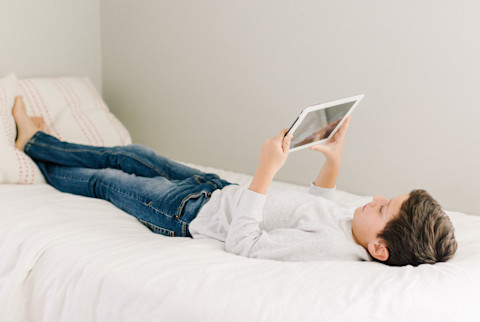Want A More Engaged & Independent Playtime? Try This Simple Method

Imagine an independent playtime, where your child learns, develops new skills—and that doesn't involve tablets, television, beeping-bopping toys, or headache-inducing clutter.
According to Simone Davies, teacher and author, it exists. Davies is the author of the new book The Montessori Toddler: A Parent's Guide To Raising A Curious and Responsible Human Being, where she breaks down the century-old teaching method.
The Montessori method is a child-rearing framework with the basic principle that children, naturally, are eager to be independent and learn if you give them an encouraging environment.
"It subverts our normal expectations for teaching, which is top-down: where the teacher stands in front of the room and leads the classroom," says Davies. "In this method, we let the children control what and how they learn [within certain perimeters]. It creates a setting that is very hands-on; we want them to engage and grow by trying it all out for themselves."
So what does this mean exactly for playtime? Giving over some of the reins of control to your child. (That's it; that's the trick.) "It sounds intimidating to a lot of adults," says Davies. "But you'll find your kid is way better at it than you would have ever thought."
Here, how to use the method in your own life.
Let them pick screen time.
If your child is old enough for screens, agree on a time limit that you feel comfortable with. (Try 30 minutes, says Davies.) Then, in true Montessori fashion, let them decide what that time means: "Maybe they want to watch television, play a computer game, or be on the internet," says Davies. "Obviously you can monitor what program or game, but letting them choose what 'screen time' means to them makes the time more exciting."
Most important, however, is to make sure you're not just giving them a screen mindlessly. "A few minutes here, a minute there—that adds up," says Davies. "Before you know it, they've spent hours a day on your phone." This screen time, however, becomes more of a crutch rather than an active, engaging choice for your child. Of course, notes Davies, this might mean creative intervention while in public: When they get restless at, say, a restaurant, instead of handing them a game on your phone, maybe it means going to look at the people on the street or opening a coloring book.
Fewer toys leads to better play.
Maximizing your kid's playtime is shockingly (and purposefully) simple: By reducing overstimulation and letting them pick what they play with, they'll engage more with the activities you've given them. "Less is more," says Davies.
Stick to six to 10 options ("Your child can only master a few skill sets at a time," says Davies). And keep it within reach of the child, so it's easily accessible during playtime. "You should think about things through your child's perspective—literally get on their level and see how they view the space," says Davies. When you can see how your child views the play space, you can curate what toys or activities they are drawn to, "instead of the remote or iPad," says Davies.
Davies also recommends toys made with natural materials, like wood, metal, and paper, instead of those plastic, flashy things. First, your child is going to be touching and playing with these, so you'll feel more comfortable with them doing so with natural materials. Second, the tactile sensation will be different for each material—not like plastic, which tends to feel the same—so it's a more stimulating experience. (Oh, it's also more sustainable.)
A few good examples: Give them a bin of wooden blocks and let them build, a tray with tools for water painting, a basket of their favorite books, or a puzzle. (As for your other toys? Donate or store away!)
Keeping the space calm will help.
"I'm not sure at what point we decided that kids' decorations should be overwhelmingly bright, but that doesn't help guide them because they don't know where to look," says Davies. "Instead, create a calming neutral backdrop where they'll only be drawn to the bright, fun activities."
Then, designate space for the activities: Create a cozy reading nook with blankets and pillows, keep art supplies on a tray so they know what goes together, or provide a yoga mat for them to play with Legos on.
This might take more preparation now, but in the long term, the results will be more rewarding for you and your child.
